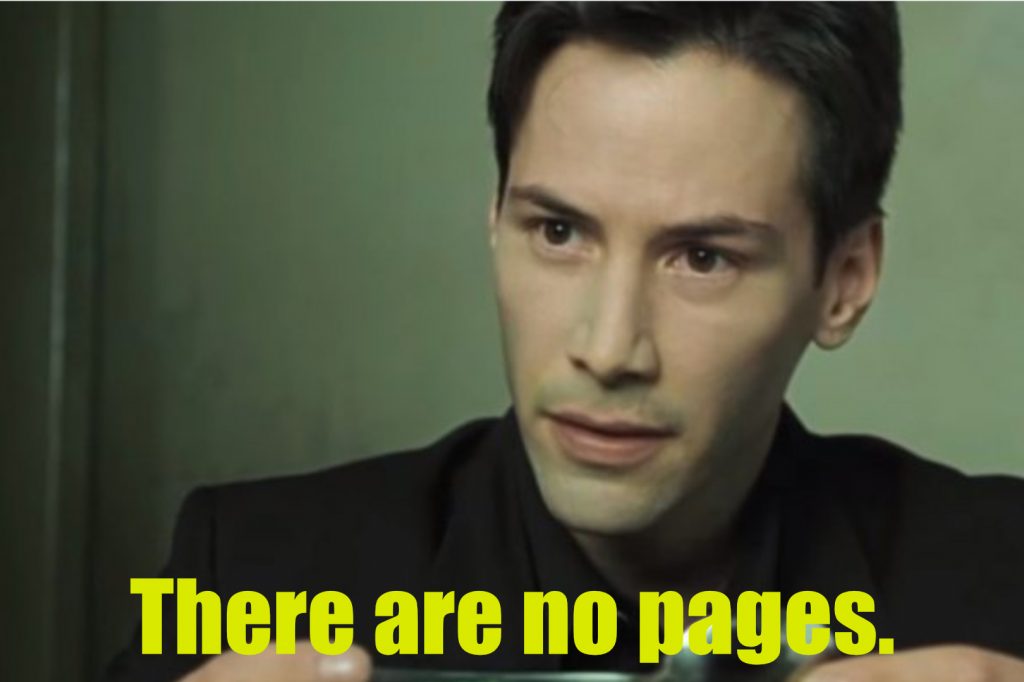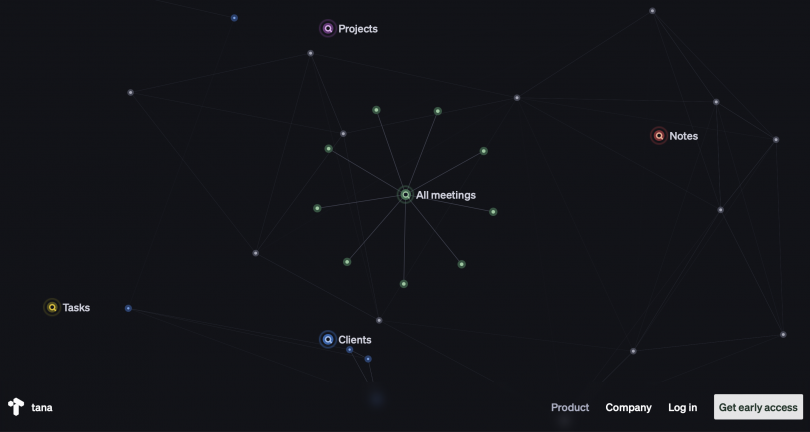With a growing number of vocal online advocates … a flood of social media buzz … an increasing community of converts from Notion, Roam, Logseq, and Obsidian … and a long line of people clamoring for early access, Tana has premiered to higher levels of enthusiasm — and, occasionally, animosity — than any tool for thought I’ve encountered.
Despite my passion for Obsidian — and my plans to be on a cruise ship for two weeks of vacation — I found myself drawn into the hubbub around Tana. After watching Cortex Futura’s introductory videos, I signed up for the waiting list … and joined what seemed like a million other people hoping for an invitation to take the “early access” version of Tana for a test drive.
(My invitation came very quickly. Based on how long others have waited, I can only assume I have a mysterious and generous benefactor who has, so far, chosen not to reveal him/her/themself. I’m deeply grateful, and I hope you’ll choose to reveal yourself at some point, just so I can say thank you directly.)
This post compiles my experience with Tana so far: what I love about it, what I’ve learned from it, what I think it lacks, and what I long for. Be informed, too, that this post ends with … a warning.
Life Before Tana
Before taking anyone’s advice on what tools to consider, I think you should know a little about that person’s background and biases. Here are mine:
I come to Tana as a previous user of Evernote, Notational Velocity, Bear, and DevonThink. Roam Research was my first experience with a modern tool for thought, and I loved its outliner format, backlinks, and community. After a year of use, though, I began to have concerns: about its mercurial founder, about certain cults of personality springing up within the community, and about the lack of privacy, security, and off-line accessibility. (By the time these latter issues were addressed, I no longer had the need or desire to continue using Roam.)
For more than a year now, I’ve been a passionate user of Obsidian — and continue to be. While curious about other tools (I’ve dallied with Logseq and Scrintal), I’ve been very, very satisfied with Obsidian’s unique blend of practicality, extensibility, privacy, and dependability.
While I would not recommend you do so, I’ve actually written an entire 75,000-word novel in Obsidian. Ulysses has features that make it, by far, the better environment for piecing together long form texts in the formats professional publishers will require. That said: Obsidian is, by far, the superior tool for capturing, organizing, linking, and developing ideas in ways that writers and researchers will appreciate.
I love Obsidian. I love that my files live on my hard drive. I love that Obsidian saves them in a human-readable format. I love Obsidian’s “trust no one” approach to security. While Obsidian is not a perfect tool, it is very close to being the perfect tool for me.
So … why bother looking into Tana (especially an early release version of it) at all?
Tana’s Appeal
For me, Tana came out of nowhere, after I returned from a month-long sabbatical from social media. Before I left, no one in my feed had ever mentioned Tana. When I came back, no one seemed to be talking about anything else.
As will be the case for many people, my introduction to Tana came from watching Cortex Futura’s introductory videos. While watching these, I began to perceive a key difference between Obsidian and Tana. Obsidian’s near-magical data-juggling requires users to engage in some fairly sophisticated and finicky programming. By contrast, Tana’s data wrangling powers are remarkably straightforward and much easier for non-programmers to understand.
I’ve long wanted the kind of power Obsidain’s Dataview plug-in offers … but each time I’ve tried to fiddle with it, I’ve gotten disappointing and frustrating results. If Tana could make it easier for me to capture metadata … and benefit from having captured metadata … then that, alone, would make Tana worth pursuing!
Things I Love about Tana
Once I had access to Tana, there were several things I loved right away.
The outlines are amazing.
If you love a good outliner, you’re going to love Tana. Just as Roam, Logseq, and OmniOutliner do, Tana makes outlining and organizing thoughts in a bullet list a snap. That’s great for me because, as a writer, I use outlines and stream of consciousness prose to explore ideas and “see what I’m thinking.”
While there’s nothing particularly novel about Tana’s functionality as an outliner … what’s happening under the hood as you outline is both new and remarkable. (More on this in a bit.)
“My God! It’s full of nodes!”

Users of Obsidian and Logseq are used to the concepts of blocks (essentially bullet points) and pages (collections of bullet points). Tana sets these metaphors aside in favor of another, more agile unit of thought: the node.
At first, new users may think “node” is just Tana’s sexier vocabulary term for “blocks” or “bullets.” Don’t make this mistake. Nodes are more nimble, in that they can be quickly and easily assigned metadata or configured to search for and display very specifically defined content. What’s more: in Tana, everything is a node.
- A bullet is a node.
- A piece of metadata is a node
- The definition for a piece of metadata is a node
- A live search that constantly updates its results in real time is a node.
- Even the so-called “daily page” is just a node — albeit one tagged with special qualities that make it pop up every day, titled appropriately and organized into a network of weeks and years.
This proves to be the key to enormous power and flexibility, because nodes can be twisted open and given qualities, values, and contexts. And since, in Tana, everything is a node, this means every bit of information in your graph can tweaked open and given be qualities, values, and contexts … and made to dance at your command.
It also means this is true:

SuperTags have superpowers.
In Obsidian, it was my practice to create pages (like “Dune,” for example) and add metadata to those pages (like a source type of “book,” an author name of “Frank Herbert,” and a genre type of “science fiction”). This is easy and works well — but later, if I want to change the metadata I track for every book in my collection (adding, say, an Amazon link or a “date completed” field), I’ll have a lot of manual work to do.
In Tana, for the node “Dune,” I create what’s called a supertag — a tag that contains multiple fields of metadata. In this case, my “book” supertag contains the fields source type, author, and genre … and those fields are automagically available for every single node in my collection tagged “book.” What’s more, when I decide to start tracking URLs and completion dates for each book, I can add these fields to my “book” supertag … and this will make those fields available in every node tagged “book.”
In Obsidian, updating my “book” metadata infrastructure is a major undertaking. In Tana, I can configure book metadata in one supertag and have that structure extended to all instances of the tag. Then, with just a couple of clicks and no programming, I can display all nodes tagged with “book,” display them as a table, limit that display to those books with missing metadata, edit their metadata in the live search, and update every book in my collection with very little investment of time and energy.
Supertags, especially when combined with live searches that update results in real time (and make those results editable on the fly) have radically redefined how I work with the data in my graph. But — perhaps more importantly — they have done so without demanding that I master arcane Dataview incantations. Instead, I point and click, label, and tweak … and in seconds, I can summon, sort, display (as tables, as cards, as lists), and add or update information in a flash.
All this, and community, too.
The Tana community (accessible through … a Slack channel!?!) is as friendly, responsible, and knowledgeable as Obsidian’s (and includes many of the same members). This bodes well for Tana, as a vibrant and approachable community has been critical to Obsidian’s rapid growth and adoption.
Leadership is present without micromanaging. They listen to ideas. They embrace criticism. They respond. They care. Instead of focusing on being personalities or luminaries or trend setters or revolutionaries or cult leaders, they are focused on making Tana better and better, as quickly as possible.
They are judiciously expanding the number of users. They are providing a rich library of onboarding tools. They are adding features so quickly that any list of what Tana doesn’t have can become outdated overnight.
All of this makes Tana — and being a Tana user — a sincere pleasure.
What I’ve Learned
Tana’s something really different.
New tools for thought seem to be popping into existence every five minutes or so. Most are clones of the others, and many, with the exception of some window dressing, are pretty much identical.
Tana is something genuinely different … and, in these early days, that uniqueness can work against it. Here’s why:
- People like to describe new things in terms of familiar things, so you’ll see a lot of statements like, “Tana is like Roam research crossed with Notion” or “Tana is Roam Research taken to the next level.” The problem is this: none of these statements are actually true, and all these resemblances are superficial, because Tana is very much its own thing.
- I’ve already seen online wonks panning Tana, complaining about Tana, mocking people interested in Tana, and rolling their eyes at Tana … often without having access to it. On the one hand, given all the hyper-inflated claims people make about tools for thought, some cynicism is warranted. On the other hand: when something new and remarkable comes along, you don’t want to pay too much attention to what others think of it … especially when those others haven’t even touched it yet!
Even as you read what I have to say, you need to reserve judgment until you experience Tana for yourself.
You’ll need an internet connection.
My invitation to Tana came just as stepped aboard a cruise ship for a two-week voyage in the Mediterranean.
One of the joys of being an Obsidian user? Thanks to local files and quick, reliable sync services, my notes are always accessible to me, even when internet connections are unreliable or absent.
With Tana (as with Roam, in those early days), an internet connection is absolutely required to use the app. Happily, Tana works smoothly even over the slowest, crappiest internet connection known to man: a cruise ship’s glacial, intermittent, overpriced WiFi. From day one, despite this limitation, Tana’s been rock-solid.
Watch out for duplicate nodes.
In Obsidian, as you create pages, you’ll be warned about and prevented from using duplicate page names. By contrast, Tana will happily allow you to create any number of identically-named nodes — and this freedom takes some getting used to.
In my case, before I really knew what I was doing, I had created two nodes named “Tana” and yet another Tana node that tagged Tana as a topic. I didn’t really notice what was going on until an effort to find a list of questions about Tana took me to a blank node. After a minute or two of panic — had Tana lost my questions? — I figured out what was going on.
In asking questions about this, I’ve learned that it’s a best practice to avoid the duplication of node names. If that’s truly the case, perhaps Tana should guide users to create unique names by default.
Supertags make screw-ups easy to fix.
At one point in my explorations, I created ReadingNotes, FleetingNotes, and Quotation supertags independently of each other, giving each fields for information about an associated Author and Book. Later, though, I came to understand two things:
- Instead of creating individual Author and Book fields for each type of note (a total of three unique Author and three unique Book fields), it’s better to create one unique Author and one unique Book field and make those same fields accessible within all ReadingNotes, FleetingNotes, and Quotations.
- Because supertags can inherit fields and information from each other, it makes even more sense to create a Note supertag with Author and Book fields, and then create ReadingNote, FleetingNote, and Quotation supertags that inherit Author and Book field types from the parent node.
If none of that makes sense, don’t worry for now. The point is this: in other systems I’ve used, making this kind of mistake when setting up structures used across multiple notes might take hours to fix. (The same amount of work might be needed if, in the future, I decided to redefine the kind of metadata recorded for all my notes.)
In Tana, I used a live search to identify duplicate nodes, pulled all existing notes into a table, and edited them all in bulk … in just a couple of minutes.
Flexible tools are the key to powerful custom workflows.
Out of the box, Tana is not particularly well-suited to do a lot of the work I do as a novelist and longform writer: planning story arcs, say, or tracking characters and throughlines across multiple acts.
In the past, building these systems on my own has been possible, but doing so has required a lot of time and effort. Maintaining these homemade systems over time has become a big administrative burden. But with Tana’s flexible, powerful supertags, I can build the custom structures I need, and then I can use live searches to generate and maintain the dashboards I want. Better yet, I can do all this with little or nothing in the way of programming expertise.
Power users of Obsidian have long been able to achieve things like this with a combination of plug-ins and Dataview programming. Being able to do this myself, using controls that make sense and don’t require coding, has been a joy.
My requirements are more flexible than I thought possible.
When choosing my personal tool for thought a year or so ago, I established these criteria:
- I wanted my data stored in local files, on my computer.
- I wanted that data stored in plain-text files.
- I wanted “trust no one” security, with none of my data available or accessible to others via the cloud.
- I wanted my tool to work off-line without any compromise in functionality.
- I wanted my tool to work almost identically on my Mac and my iPhone.
- I wanted fast, reliable syncing across all my devices.
- I wanted data portability: a clear and simple means of getting all my data out of the tool if the need arose.
Obsidian, my current tool of choice, ticks every single one of these boxes. (Hooray!)
Years ago, I left Roam behind, in part, because, at the time, it failed to check most of these boxes. (It’s gotten better.)
And now there’s Tana.
My data is stored on Tana’s servers. I’ve no idea what format that data is in. Tana’s people promise to behave and claim to audit employee access to data, but I must take them at their word about this. Tana is useless without a network connection. It is available, kind of, on iOS devices, but it almost useless on my phone. And while I can export a range of files, I’m not sure it’s currently possible to get all my content out of Tana if I needed to.
In other words: Tana, today, meets almost none of my requirements.
And, weirdly, I don’t seem to care.
Here’s all I can figure out: right now, today, Tana is so magical, flexible, powerful, and fun … I really don’t care about all the requirements it fails to meet. For now, I just love using it. (And, for now, I’m not keeping deeply personal or sensitive info there, nor am I keeping anything there I would be devastated to lose.)
What’s Lacked and Longed For
A caveat: at this writing, Tana is “early access” (that is, pre-beta) software. A lot of planned functionality is not yet implemented … and in some cases, the creators are still learning exactly how they want Tana to do things.
In addition, Tana remains in that heady rapid development phase when functionality is tweaked or added every other hour or so. It’s not unusual to see functionality requested or observations made in the Slack community … and to see a reply saying, “Okay, we’ve added that” in less than 24 hours.
All of this to say: what follows is a list of things I’m lack and long for right now. By the time you read this, some of these things may exist! (Also, some of these things may exist … but, by virtue of having used the app for only nine days, I may be unaware of some options that are available.)
- Security and privacy. I appreciate Tana’s clear statements about security and privacy policies. I would love, though, to have encryption … or, better yet, a way to use Tana’s magic while keeping my data on my own devices.
- Local storage and future-proofing. I strongly prefer to have my files on my local hard drive, in a future-proof format like markdown.
- Offline capability. For those of us who frequently travel internationally or who live in rural areas where on-the-go network connections can be unreliable, an offline mode would be wonderful.
- A official Discord group. I love how responsive Tana’s community is … but I wish my interactions with them were in Discord instead of Slack.
- Pricing. At this point in time, I have no idea what Tana’s going to cost me. I do hope it costs me something, though, because I’d like to see Tana’s future linked to a stable, sustainable growth model. (Update on 10/18 – speculative pricing information is actually online.)
- Independently-scrolling panes. In Obsidian, I can open two panes side by side and scroll them independently. If this is possible in Tana, I can’t figure out how it’s done. For those of us who like to draft in one window and polish in another, that’s deadly! (This very post, in fact, was drafted/outlined in Tana … but I had to do the actual writing in Obsidian for lack of an independently scrolling pane.)
- A clear vision for longform writing. Writers will need more clever ways to select, work with, and compile shorter text into longer files … and a way to export them into more universal formats.
Is Tana Right for You?
As with most things in life: it depends.
- If, like me, your desire for accessible magic outweighs your preferences for privacy, local storage, and offline-use … then you should probably give Tana a try. If those preferences are deal breakers, you better stick exclusively with Obsidian!
- Are you nervous around early-release software? If so, you should know that Tana isn’t even in beta yet. You might want to steer clear until development progresses.
- Are you eager to have access to the power of things like Dataview, but feel intimidated by the programming required to make that magic happen? Tana makes that magic more accessible, using methods that are faster and more forgiving.
- Do you need a solution right now? If so, you should be aware there’s a waiting list for Tana access. The creators say they want to do away it with as quickly as possible. That said: if you need to get started with a tool for thought today, at the time of this writing, Tana may not be your best option.
- If you prefer working in a full-featured outliner over working in less structured space, you’re going to love Tana.
- If you’re a long-form writer, you are going to love planning and visualizing work in Tana … but a tool like Obsidian or Ulysses is currently your best environment for drafting and polishing work you plan to publish. (For what it’s worth, I think this will change rapidly, and that Tana’s tools are going to make amazing and unprecedented things possible for longform writers in the near future.)
- Do you deal well with uncertainty? Jump in. If not: Obsidian and Logseq are better options.
My Personal Plan
From the day I first mentioned Tana, my inbox has been full of messaging asking the same question: “Are you leaving Obsidian for Tana?”
Nope.
Let me be clear: I love Tana. I love its power. I love what it’s capable of. I love what it allows me to do, quickly and easily, for the first time ever. I love its community. I love its creators and leaders. I love this giddy early development period. I love experimenting with Tana and learning about new ways of working. I love Tana’s potential.
And … I love Obsidian. I love its power. I love what it’s capable of. I love what it allows me to do, quickly and easily. I love its community. I love its creators and leaders. I love its stability and maturity. I love tinkering with it, and learning about new ways to use it to get work done. I love its off-line, local, future-proof handling of my data. I love Obsidian’s present state … and I love its potential, too.
For me, these are different tools, with different use cases, that I’ll be employing for different purposes.
- Today, I’m doing most journaling in Tana, but any deeply personal work (or dream journaling, for example) will remain in Obsidian.
- For now, as I learn to use Tana more efficiently, all my note-taking on books, videos, podcasts, and posts will go into Tana. I will probably also start manually porting over the most frequently-used notes from Obsidian, just to learn what I can from that process.
- Any information I need when offline and on the go — like my daily plans for the vacation I’m currently on — must remain in Obsidian, of course.
- Will I start planning longform fiction in Tana? Absolutely. Do I feel inclined to write a novel in it? Nope.
In Parting, A Word of Caution
Right now, I am on vacation in the Mediterranean. There’s a great deal to do and see, and our days are so full of walking from place to place, we’re pretty exhausted by the time we get to bed.
Even so, for three nights in a row, I found myself waking up early … and being so excited about what’s going on with Tana that I crawled out of bed and spent a happy hour or two exploring.
This is the first time I can recall being so excited about a tool … that I’ve been willing to get up in the middle of the night, just to play around and see what’s possible.
This has reinforced my gut feeling that, whatever Tana is, it’s something very different from what I’ve worked with before … and something worth the time it takes to align its strengths with the way I get things done.
Prone to a bit of obsession, then?
You’ve been warned.







